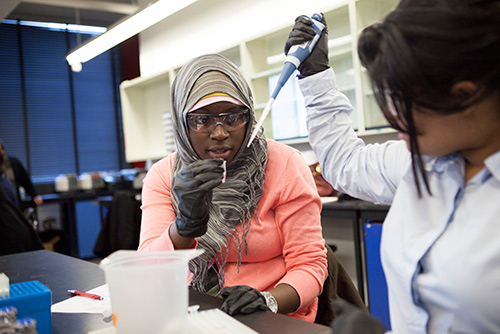
Chelsea High School students Neris Yanes (left) and Karina Perez (second from right) work with research assistant Alia Qatarneh and Chelsea High teacher Melissa Puopolo (right) on a lab exercise involving RFP-expressing bacteria.
Photos by Katherine Taylor/Harvard Staff Photographer
Learning life in the lab
Harvard program helps high school students tap their inner scientists
High school students from Chelsea tried their hands at a little genetic engineering last Thursday, in a lab exercise at Harvard’s Science Center that first coaxed bacteria to produce a red fluorescent protein, and then harvested the material.
The group of about 15 students carefully followed steps outlined on the blackboard by research assistant Alia Qatarneh. In the process, they completed the Amgen-Bruce Wallace Biotechnology Lab Program, an eight-lab biotechnology course supported by the Harvard Life Sciences Outreach Program and funded by the Amgen Foundation.
“For over a decade, the Outreach Program has shared the technology of our teaching labs [with area schools] through class visits to campus,” said Robert Lue, outreach program director and professor of the practice of molecular and cellular biology. “The Amgen program gives us another way to package technology with curriculum in a manner that brings it to the schools. The bidirectional combination of approaches maximizes the beneficial impact of Harvard’s resources in the life sciences.”
The course is made available to high schools around the state. The Outreach Program provides instructions for eight labs and lends the schools kits that include $20,000 in chemicals and equipment that many schools couldn’t otherwise afford, such as centrifuges, hot water baths, and thermal cyclers (also known as PCR machines, for polymerase chain reaction) that amplify DNA.
“The class would not be happening at Chelsea High School without this program,” said Melissa Puopolo, a science teacher at the school.
“I don’t have a centrifuge,” she said. Having access to “the equipment is huge; the PCR machine is really expensive.”
The biotech outreach effort has proven popular, according to Tara Bennett, the program manager. In its first two years, it has served 5,000 students in 50 schools across the state, from Yarmouth on Cape Cod to Lee along the New York state border. What that means, however, is that the kits can be loaned out for just three weeks at a time. Because Chelsea had to return the kit before finishing the final lab, the students traveled to Harvard to complete it.
“It is a tight schedule,” Bennett said. “These are big-ticket items whose cost is preventing teachers from introducing students to the [biotechnology] equipment.”
The processes used in Thursday’s lab are standard in biotechnology, Bennett said, and can be used to get bacteria to produce biological products such as the red fluorescent protein — which is used to tag other molecules so scientists can track them — or important therapeutic substances such as insulin.

The students learn that science is sometimes messy and that experiments don’t always turn out as planned. In the labs, Puopolo said, students get hands-on experience that could give them a leg up in college or even help them land a biotech job out of high school.
“They can say … ‘I can work with DNA or pour gels,’ ” Puopolo said. “There are so many jobs in biotech in the area.”
Neris Yanes, a junior at Chelsea High, said she liked the lab work because it allowed her to participate rather than just listen. Bahiya Nasuuna, a senior, enjoyed the clear steps outlined in the lab and said science may be in her future.
“Science is my favorite subject. I definitely want to pursue it in college,” Nasuuna said.




